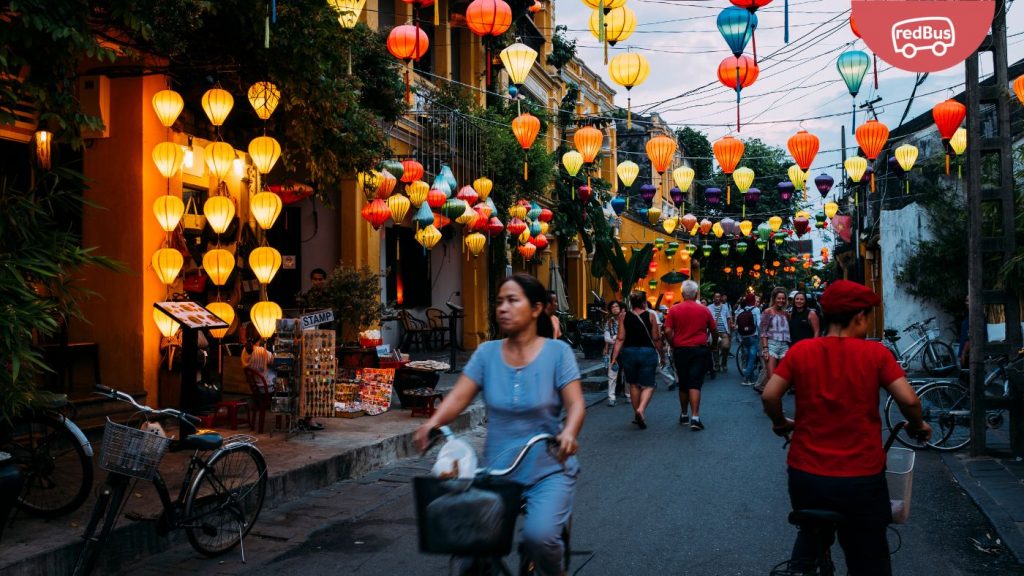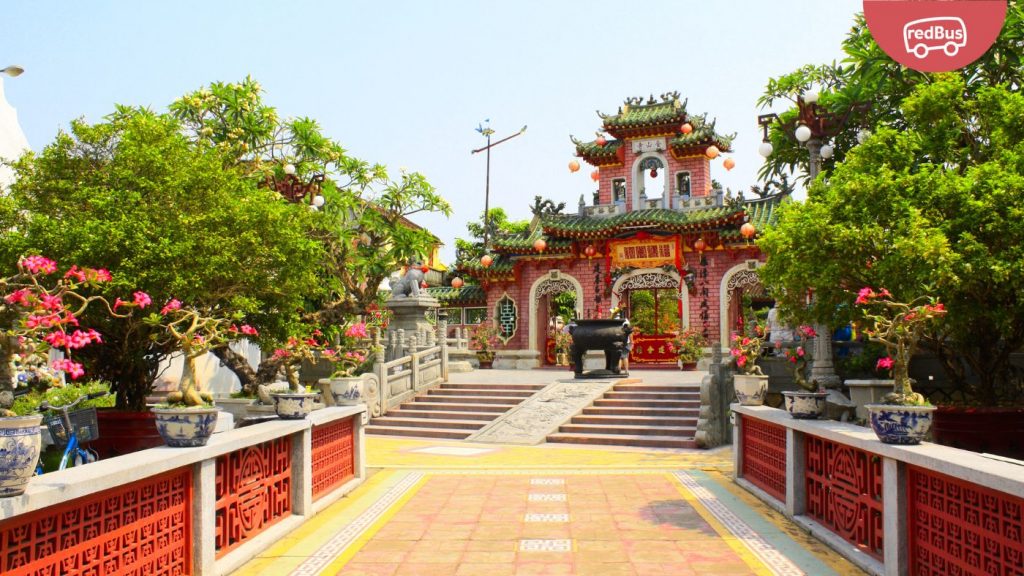The Hoi An Lantern Festival is an event observed on the 14th day of the lunar month and is considered sacred in the Buddhist calendar. Amongst its many phases, the full moon holds particular significance, inspiring beach parties and festivals across the globe. In Vietnam, the enchanting Hoi An Lantern Festival is a celebration that draws visitors in with its luminous displays and vibrant traditions.
History of the Hoi An Vietnam Festival
Legend tells that Buddha was not only born on a full moon but also attained enlightenment under its gentle glow. For centuries, Buddhists have viewed the full moon as an auspicious time for transformation and reflection.
This tradition extends to modern times, with people across Asia using the full moon as a time for meditation, ancestral worship, and offering prayers at family shrines. In recent years, these customs have beautifully transformed into the captivating spectacle we know today as the Hoi An Lantern Festival.
Vietnam’s strong Buddhist roots have always placed emphasis on the full moon. However, the unique tradition of lanterns in Hoi An truly flourished during the 16th and 17th centuries when the city thrived as a bustling port. Merchants from around the world, including the Japanese, brought with them a variety of shaped lanterns, which they would hang in front of their dwellings. Inspired by this custom, locals began to adopt the practice, hoping to attract similar good fortune to their own homes.
Hoi An has retained its diverse cultural influences over time, becoming synonymous with the beauty of lanterns. In 1988, local authorities made the ingenious decision to combine these lanterns with the existing full moon celebrations. Since then, the festival has grown in popularity, attracting both Vietnamese and international travelers eager to experience this mesmerizing event.
Where does the Lantern Festival take Place in Hoi An ?
The festivities unfold along the banks of the Hoai River, with the An Hoi Bridge marking a central point. Enjoy a leisurely walk from your hotel in Hoi An City Center, or hop on a taxi or shuttle for a quick 10-15 minute ride from the beach to witness the magic unfold by the water’s edge.
Dates of the Lantern Festival Hoi An – 2024
| January | February | March | April |
|---|---|---|---|
| Jan – 24th | Feb – 23rd | Mar – 23rd | Apr – 22nd |
| May | June | August | July |
| May – 21st | June – 19th | Aug – 17th | July – 19th |
| September | October | November | December |
| Sept – 16th | Oct – 16th | Nov – 14th | Dec – 14th |
Highlights of the Hoi An Festival in Vietnam
The full moon festival is celebrated throughout Vietnam, but the UNESCO-listed town of Hoi An has become the undisputed champion for experiencing the magic of this monthly event. The area between the Japanese Covered Bridge and the Cau An Hoi Bridge is the epicenter of the festivities. As much of the town is pedestrianized, exploring different vantage points becomes a delightful adventure.
Light Lanterns

As the name suggests, the highlight of the festival undoubtedly lies in the lanterns themselves. These colorful creations, meticulously crafted by hand, are lit with candles and gently placed upon the Thu Bon River. As wishes for happiness, luck, and love ascend with the glowing lanterns, a magical atmosphere descends upon the town.
At 8 pm, a captivating transformation takes place. The fluorescent lights of the city fade away, leaving the stage illuminated solely by the soft glow of countless lanterns. The absence of vehicles and bicycles in Hoi An’s old quarter allows visitors to wander freely, soaking up the enchanting ambiance.
Enjoy the Festivities and Music
The riverside comes alive with the melodious sounds of traditional music, featuring instruments like bamboo flutes, drums, and fiddles. Poetry readings add another layer of cultural richness to the evening. Locals gather outside their homes, engaging in friendly games of board games, while others participate in “Bai Choi,” a captivating musical version of bingo.
Relish Delicious Foods

Mouthwatering street food stalls line the river, offering an array of delectable vegetarian and classic pork dishes. This is the perfect opportunity to indulge in traditional moon cakes, pastries filled with sweet red bean paste, and explore the bustling night markets.
Savor the unique flavors of Cao Lau, a dish featuring roasted pork, greens, and rice noodles, reminiscent of Japanese soba noodles. Com Ga Hoi An, a local take on Hainanese chicken rice, is another must-try. For a taste of the vibrant street food scene, explore the night markets and indulge in Banh Bao (steamed rice dumplings), Banh Beo (local steamed rice pancakes), or the sweet and delectable moon cakes.
Participate in Rituals and Visit Temples

The Hoi An Lantern Festival is not just about the visual spectacle; it’s also a time to honor deceased relatives and ancestors. Local families visit shrines, presenting offerings of flowers, food, and candles. The burning of “fake money” symbolizes the exchange of prosperity for the afterlife.
Hoi An is a treasure trove of historical landmarks. During the Lantern festival, you can visit the temples and Pagodas to witness the celebrations. Pay homage at the Quan Cong Temple, adorned with striking gold and red colors, or explore the Tan Ky Old House, considered the town’s most beautiful and ancient residence. The Japanese Covered Bridge, a symbolic landmark dating back to the 18th century, offers a romantic setting for capturing memories.
Tips for an Unforgettable Lantern Festival Experience
To fully embrace the magic of the Hoi An Lantern Festival, keep these helpful tips in mind:
- Secure your camera: Considering the close proximity to the river, a wrist strap for your camera and a lanyard for your phone are essential to avoid accidental drops.
- Plan your visit: February is widely considered the peak time to experience the festival at its most vibrant. The first full moon of the lunar new year brings the largest celebration of the year.
- Embrace the local craft: Purchase a handmade lantern for a mere 50 cents from local vendors. They’ll often provide a long pole to help you gently lower your lantern onto the water.
- Arrive early for a good spot: The festival attracts large crowds, both local and international. Reaching Hoi An’s riverbanks early ensures a good viewing position for the mesmerizing spectacle of candlelit water.
- Escape the Crowds (optional): For a less crowded experience, consider a traditional sampan ride on the Thu Bon River. This unique perspective allows you to observe the festivities from a distance and gently place your lantern on the water’s surface. Expect to pay around USD $5 for this experience.
- Comfortable footwear is key: Sturdy shoes are recommended as navigating the bustling streets can get crowded. Be prepared for the occasional bump as you soak up the vibrant atmosphere.
Reaching Hoi An
Hoi An itself doesn’t have its own airport, so getting there involves flying into a nearby airport and then continuing your journey by land. Here are the most common ways to reach Hoi An:
- Flight: Da Nang International Airport (DAD) is the closest major airport to Hoi An, located about 30 kilometers away. Many international airlines and domestic carriers offer flights to Da Nang from various locations.
- Bus and Limousines: You can book your Vietnam bus tickets on platforms like redBus and save more on your Hoi An tickets. Choose popular bus operators iHome, Barri Ann Travel, Vietnam Explore, Camel Travel, Queen Cafe and others as per the routes. You can get up to 25% off with promo codes and exclusive offers on iHome transfers. (terms and conditions apply)
Learn more about Bus Booking in Vietnam
From Da Nang Airport to Hoi An:
- Taxi: This is the most convenient option, offering a comfortable and direct journey. Expect the ride to take around 45 minutes to an hour depending on traffic conditions. Fares are typically metered, so negotiate beforehand if necessary.
- Shuttle Bus: Several shuttle bus companies offer transfers from Da Nang Airport to Hoi An. This is a more budget-friendly option compared to taxis, but it may take longer depending on the number of stops made.
- Private Car: You can pre-arrange a private car transfer from the airport to your hotel in Hoi An. This offers a comfortable and personalized experience, especially if you have luggage or a group of people.
Alternative Airports:
- Hanoi (HAN) or Ho Chi Minh City (SGN): If you can’t find a convenient flight to Da Nang, consider flying into Hanoi or Ho Chi Minh City, the two largest airports in Vietnam. From there, you can connect to Hoi An by domestic flight or take a longer train or bus journey.
Additional Considerations:
- Visa: Depending on your nationality, you may require a visa to enter Vietnam. Research visa requirements well in advance of your trip.
- Transportation Booking: Consider booking your taxi or shuttle service in advance, especially during peak season, to ensure a smooth arrival.
